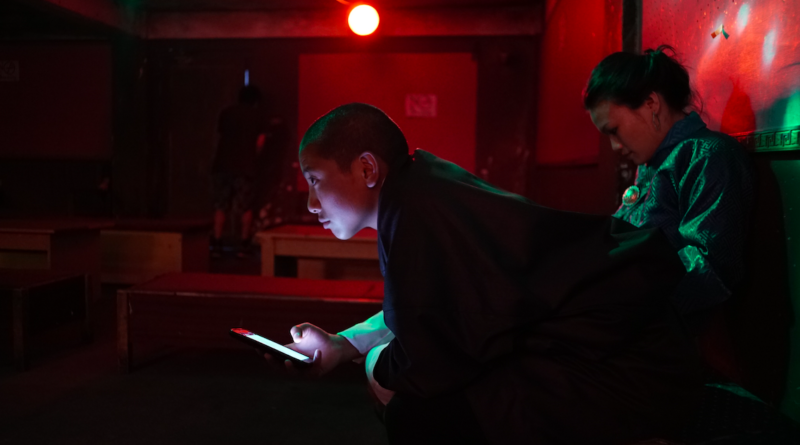INTERVIEW: ‘Sing Me a Song’ documents impact of connectivity in Bhutan
Photo: Sing Me a Song follows Peyangki, a Buddhist monk, as he navigates a connected world. Photo courtesy of Participant / Provided by press rep with permission.
Sing Me a Song, the new documentary by filmmaker Thomas Balmès, serves as a followup to his well-received film Happiness from 2014. Both movies follow Peyangki, a Buddhist monk living in Bhutan who is learning the ways of the world and the intricacies of his religion. In the first film, Peyangki is 8 years old, while this new documentary finds the subject in his late teens. The contrast between the two images is stark because this time around the monk has become enamored with the internet possibilities found on his smartphone.
Bhutan, a relatively small country high in the Himalayas, received access to the internet and televisions in the late-1990s, according to press notes. Other technology, like smartphones, eventually came to the country, and the population, much like the rest of the world, has been greatly impacted. As depicted in Sing Me a Song, the younger generation is dedicated (perhaps even addicted) to their personal screens, which are gateways to texting, dating, gaming and fun.
For Balmès, this addition and new threat to the traditional Bhutanese culture was fascinating enough for a return trip.
“I thought that maybe doing a film on the subject of the relationship to screens, mobile phones and TV could be a good thing for me to do,” the director said in a recent phone interview. “I started to look for a country where virtually there was no screens at all, and they were about to get something. And there are not that many places in the world where you can find that. I always wanted to go to Bhutan, and I heard about how TV had arrived in 1998. And I started to research and realize that not the whole country was connected, and there were still a few villages in Bhutan which were waiting for the arrival of electricity to be potentially connected.”
One of these villages is where Peyangki resides in a monastery that hangs off a beautiful cliff in the picturesque countryside. The location is 4,000 meters high (13,000 feet), and the nearest road is quite distant.
“You had to walk for two days to reach it, and then when I arrived I very quickly went to search for someone who potentially had never left the village and never seen a screen in his life because some of the villagers in the winter when it was too tough were coming down into the valley,” Balmès said. “And very quickly I realized that there were not that many kids, even adults, in the village which were in this situation. This is how I decided to follow Peyangki.”
Filming in Bhutan is extremely expensive. Balmès said that there is a daily fee for every tourist and member of his crew, and so the director needed to rely on co-financing and a slimmed-down team to get the job done. “Besides that, I would say this is a very easy place to work and very friendly population, and everything was smooth,” he said. “[Because of] the difficulty of reaching the location, which needed horses, you needed to bring everything.”
When Balmès saw the impact that mobile phones had on the Bhutanese population, including Peyangki, he became quite said. Of course, the country’s residents have every right to connect with the outside world and take advantage of social media and dating applications. To argue that point, in the director’s mind, is essentially bringing a western perspective to this Asian country, but still the filmmaker sees some negative aspects.
“There is absolutely no sadness on their perspective, and they are very happy to be connected with the rest of the world,” he said. “I don’t see any reason why they should be kept aside from that. I feel some sadness not so much for them but for the whole planet in its incapacity to deal with this technology in the right way. I don’t have anything against screens. I am a filmmaker myself, and I grew up watching a lot of films and screens. But it all depends on what you’re doing with the screens and with this technology, and at what age it’s coming, and what kind of pace, and what kind of content. I would say that things have changed a lot in how … this new generation is addicted.”
Balmès even said that as a parent of three teenagers he is concerned about the new generation. He admitted that his own children, much like others throughout the world, used to play saxophone and construct sculptures in their younger years. Now, their phones are their main occupation.
“If you just take it away, they’re just going to be like a drug addict,” the director said. “This is a bit different from what I was going through when I was their young age with TV and other things we had, so I would say Bhutan is nothing different than the rest of the world. They just jumped from nothing to huge consumerism of these programs and apps and all that with absolutely no history or background, and this makes it special because they were so hungry for all that. … It’s something that is uncontrollable a little bit. Whatever your background is, whatever your religious background, you can be a Buddhist, you can be a monk, you can be anything, you can be young or an adult, the power and the efficiency of the addiction which is developed through all these tools is the same everywhere.”
By John Soltes / Publisher / John@HollywoodSoapbox.com
Sing Me a Song, directed by Thomas Balmès, is now available on VOD. Click here for more information.

